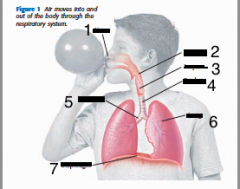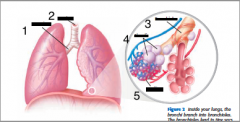![]()
![]()
![]()
Use LEFT and RIGHT arrow keys to navigate between flashcards;
Use UP and DOWN arrow keys to flip the card;
H to show hint;
A reads text to speech;
43 Cards in this Set
- Front
- Back
|
respiratory system |
The group of organs that work together to take in oxygen and release carbon dioxide |
|
|
nose |
is the main passageway into the respiratory system. |
|
|
What does the nose do in the respiratory system? |
filters, warms , moistens and the air we take in.
|
|
|
What are tiny hairs in the nose called and what do they do? |
They are called cilia.Cilia line the inside of the nose to filter dust and particles in the air we breathe.
|
|
|
Throat |
pharynx |
|
|
What are the 2 tubes that the pharynx divides into? |
esophagus and larynx |
|
|
esophagus |
where food and drinks go to the stomach |
|
|
larynx |
where the vocal chords are located
|
|
|
What does the epiglottis do in the respiratory system? |
it covers the entrance to the larynx so food and drinks do not go into the wind pipe.
|
|
|
what are vocal cords? |
they are a pair of elastic bands that stretch across the larynx.
|
|
|
muscles connect _______________________________ |
to the larynx and control how much the bands are stretched.
|
|
|
Air flows______ the vocal chords and they vibrate, which produces a sound.
|
between |
|
|
what does the pitch of the sound depends on? |
The pitch of the sound depends on how stretched the bands are.
|
|
|
what does the larynx guard? |
The larynx guards the entrance to the trachea, or the wind pipe.
|
|
|
The trachea splits into two branches called_____ |
bronchi (bronchus is singular).
|
|
|
One bronchus connects to each ________ |
lung. |
|
|
Each bronchus splits into branches called _______
|
bronchioles. |
|
|
Bronchioles split to form small air pouches called __________
|
alveoli. |
|
|
capillaries |
small blood vessels that surrounds alveoli, where blood picks up oxygen and drops off carbon dioxide.
|
|
|
Alveoli are surrounded by small blood vessels, called __________, where blood picks up oxygen and drops off carbon dioxide.
|
capillaries |
|
|
What is breathing ? |
inhaling and exhaling- taking in air and letting air out.
|
|
|
respiration |
*)Your body getting and using oxygen and releasing carbon dioxide and water |
|
|
What are two parts of respiration? |
*breathing *cellular respiration |
|
|
breathing |
*)taking air in and letting it out |
|
|
cellular respiration |
using oxygen to release energy from food.
|
|
|
Air is forced into and out of the lungs, but your lungs do not have _________ of their own |
muscles |
|
|
what is the diaphragm? |
is a dome-shaped muscle below the lungs that allows breathing.
|
|
|
What happens when the diaphragm contracts? |
it moves down. This lowers the pressure in the lungs and air is forced into the lungs- you inhale.
|
|
|
Exhaling |
it is the opposite of what happens when the diaphragm contracts. Diaphragm relaxes and moves up, so the pressure in the lungs increases and air is forced out.
|
|
|
Intercostal muscles |
muscles are rib muscles. |
|
|
what do intercostal muscles help you with? |
help with breathing by contracting and moving the ribs upward and outward to increase the size of the chest cavity, which lowers the pressure, forcing air into the lungs (inhaling) |
|
|
What happens when intercostal muscles relax? |
the ribs move back down and in, decreases the size of the chest cavity, which decreases the pressure in the lungs, and air is forced out (exhaling). |
|
|
Oxygen is taken in to the lungs and reaches the body cells through the ________.
|
blood |
|
|
What does oxygen react with to produce ATP (ENERGY) in the mitochondria of our cells? |
glucose |
|
|
During this process, ________ and _________ are produced. The carbon dioxide travels back to the lungs to be released.
|
carbon dioxide water |
|
|
What happens when you have asthma ? What causes it? |
a. bronchioles narrow making it hard to breathe b. caused by irritation (dust, pollen, etc)
|
|
|
What happens when you have emphysema? what causes it? |
a. alveoli are damaged b. decreased lung capacity c. caused by smoking |
|
|
epiglottis |
*)a flap that covers the larynx when we swallow food and drinks to prevent choking |
|
|
How do the vocal chords work? |
* Air flows between them making them vibrate. |
|

label 1,2,3,4,5,6,7 |
1. nose 2. pharynx 3. larynx 4. trachea 5. bronchus 6. lung 7. diaphragm |
|

label 1,2,3,4,5 |
1. bronchus 2. trachea 3. bronchiole 4. alveoli 5. capillary |
|
|
alveoli |
*)small air pouches in the lungs where oxygen and carbon dioxide are exchanged. |
|
|
List what happens in the respiratory system |
Blood picks up oxygen at the alveoli and takes it to the cells. Blood also picks up glucose at the villi of the small intestine and takes it to the body cells. In the mitochondria of the body cells, the oxygen and glucose combine to make ATP, carbon dioxide, and water. The ATP is used as energy for the cells to be able to function. The carbon dioxide is carried back to the lungs by the blood. |

